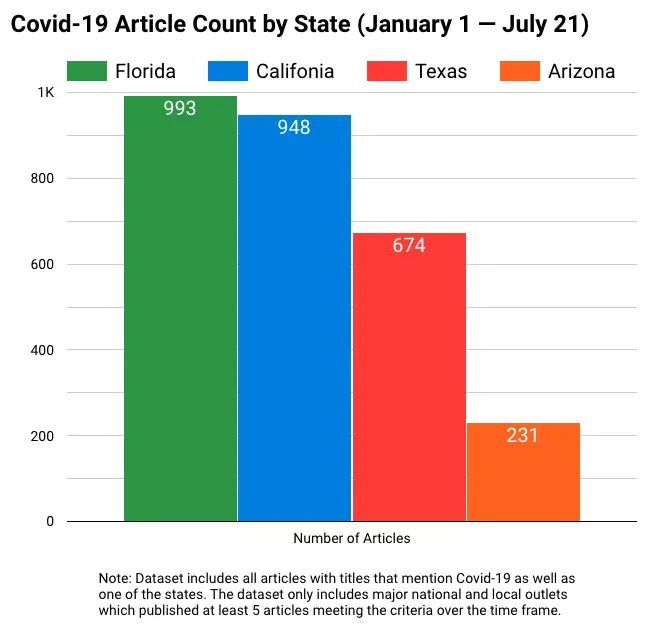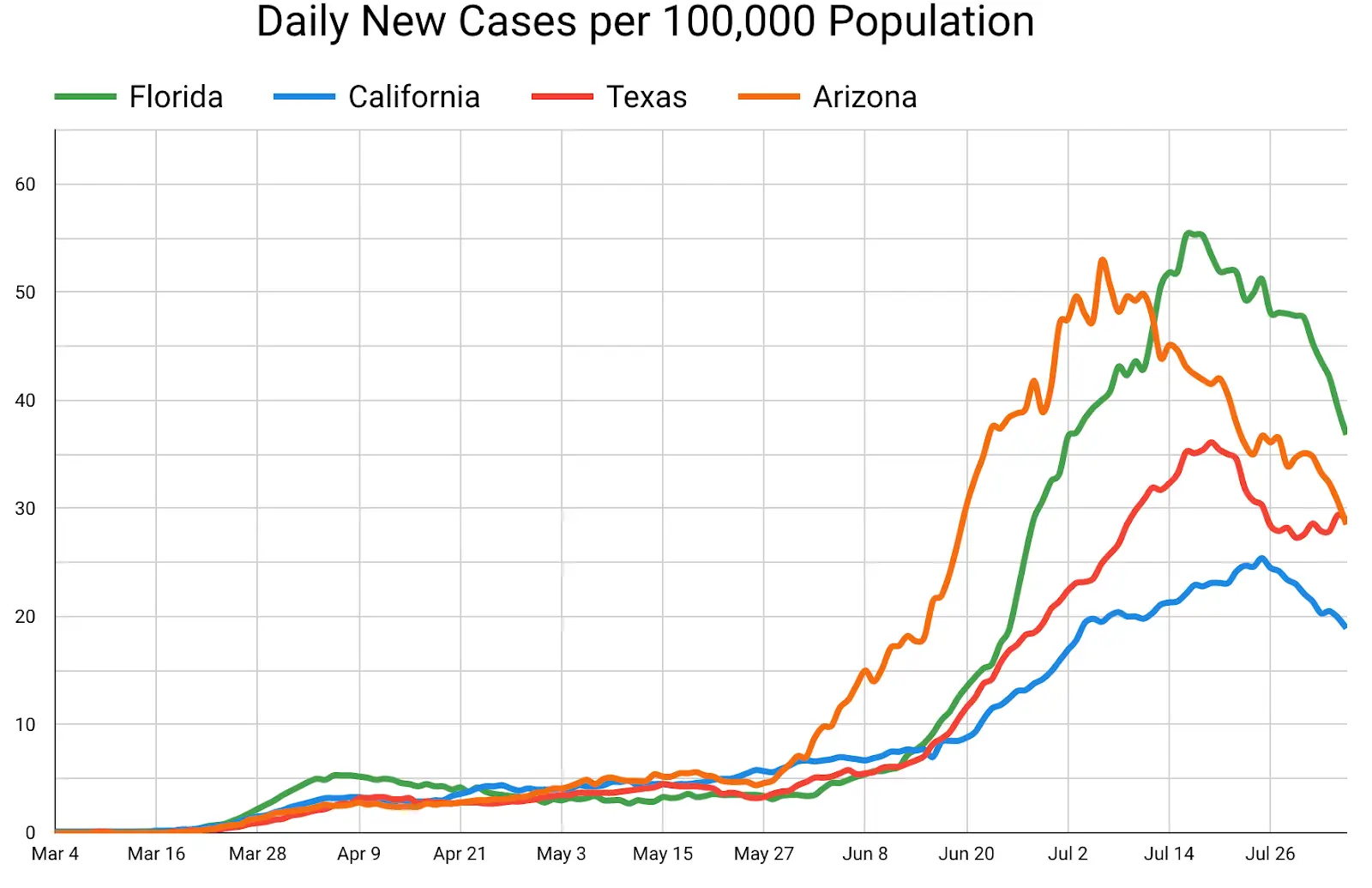A new Gallup/Knight Foundation poll shows that 73% of Americans think that bias in media coverage is a major problem. Indeed, a Bloomberg Opinion piece in early July lamented that California just wasn’t being criticized in the media the same way that Republican-run states such as Florida, Texas, and Arizona were. Though such a sentiment closely follows American’s expectations of the media, data suggests it isn’t actually true — at least not when it comes to media’s coverage of Covid-19 across different states.
The article highlighted specific pieces from left-leaning news outlets that make it seem like there very well is an imbalance in the way the media was covering recent spikes in the four states. They featured titles like “Florida invited the nation to its reopening — then it became a new coronavirus epicenter” and “How Texas Swaggered Into a Coronavirus Disaster.”
According to the author of the Bloomberg Opinion piece:
“It’s pretty obvious why California and Newsom haven’t been pummeled [in the news] the way Florida, Texas and Arizona have. California is a Democratic state. Newsom is a Democratic governor. Bringing up California’s pandemic woes punctures the critics’ narrative that Republican mismanagement is the reason for the scary surge in infections.”
Please check your email for instructions to ensure that the newsletter arrives in your inbox tomorrow.
What Does the Data Say?
Data from The Factual suggests otherwise. The notion that there was an unfair wave of “finger-wagging” against Republican-run states in the media is only true when seen through a handful of headlines. The Factual’s data — which looks at national and local news outlets for articles with titles that mention Covid-19 and one of the four states — shows that this alleged politicized news coverage (at least in this context) may be more bluster than truth.
The Factual’s algorithm analyzes over 10,000 articles a day from news outlets across the political spectrum. This gives us great data on the article output of major national and local news outlets. To read more about how our algorithm works, visit our How It Works page.
The data as a whole, which covers the output of 54 relevant national and local news outlets (2,846 articles) from January 1 to July 21, shows a rather more balanced spread of stories. In that period, California and Florida received a roughly similar amount of coverage, 948 and 993 articles, respectively. Meanwhile, Texas and Arizona both received substantially less coverage, at 674 and 231 articles, respectively.

Additionally, left-leaning media outlets were responsible for proportionally more Covid-19 coverage about California than about any of the other three states. Left-leaning sites produced 57% of all stories about California in The Factual’s dataset, compared to 52% in Florida and Arizona, and 47% in Texas. Of course, these numbers should be taken with a grain of salt, since they are likely affected by the demographics and nature of media markets in each state (e.g., through the number of articles produced or the number of outlets needed to serve the population). But at the very least, they seem to dispel the notion of a right-left imbalance in the amount of coverage.
The author of the Bloomberg Opinion piece specifically highlights the politicization from outlets such as the New York Times and the Washington Post, but The Factual’s data shows these outlets did not produce any great imbalance in news coverage. The New York Times wrote twice as many articles about California (30) as it did about Florida (15) and wrote even fewer about Texas (12) and Arizona (4). The Washington Post wrote fewer articles about California (19) than Florida (30), but it also published fewer about Texas (16) and Arizona (8).
Rather than being specifically complimentary of California and derisive of the other three states, this coverage also seems consistently negative, and for good reason. An inspection of New York Times and Washington Post titles from May, June, and July reveals no titles that shed positive light on any of the states. Instead, the coverage is all-around pessimistic, like those from the New York Times below.
“The Pandemic and Protests Have Exposed the Truth About California” – Miriam Pawell
– “The Golden State is less exceptional and more like the rest of America than many would prefer to believe.”
“Florida, America’s Pandemic Playground” – Michelle Cottle
– “Florida seems poised to become a Covid-19 theme park of sorts, a place willing to host large-scale, high-profile gatherings that more skittish — or perhaps more sensible — communities have deemed too hot to handle.”
“Texas Republicans Have Spectacularly Failed the Coronavirus Test” – Mimi Swartz
– “My faith in their ability to fix this mess is lower than the water levels in West Texas creek beds in August.”
The Case for California
Even if people were writing in a more flattering way about California (which doesn’t seem to be true), the disease is less intense in California, giving them a reason to do so, even if only marginally. The Bloomberg Opinion piece highlighted a few absolute statistics, such as how quickly California registered its second 100,000 cases, as evidence that California’s Covid-19 experience was comparably bad, but the piece fails to put those numbers in a per capita context, thereby eliminating much of their value for comparison.
On a per capita basis, California’s curve has proven less pronounced than Florida, Texas, or Arizona, despite having the most cases of any state. For example, the latest CDC figures do show California having a lower per capita infection rate (1,264 per 100,000) than Florida (2,228), Texas (1,500), and Arizona (2,468). Indeed, California’s per capita infection rate is lower than the national average (1,404).
Likewise, if one considers the rate of daily new infections per 100,000 population, California’s peak this summer (25.4 per 100,000) was considerably lower than Florida (55.3), Texas (36.1), and Arizona (52.9). Both of these trends were true, if less pronounced, on July 10, when the opinion piece was originally published.

Data from Covid Act Now
Please check your email for instructions to ensure that the newsletter arrives in your inbox tomorrow.
Save Criticism for Where It’s Warranted
If anything, the data shows the more mundane reality of most of the news coverage. It is far more balanced and more matter-of-fact than national political narratives would lead us to believe. Articles tend to focus far more on case counts and problematic hot spots such as nursing homes or prisons than they do on the assignment of blame or some nationwide political chess game.
Media bias needs to be acknowledged, especially where it may harm readers’ interpretations of reality, but we also should be careful not to decry negative media bias when the evidence doesn’t corroborate it. The author of the Bloomberg piece was eager to show that “party affiliation is not the reason cases are on the rise in various states” but readily invokes the same affiliations as the basis for a narrative of skewed media coverage, where left-leaning outlets are unfairly deriding Republican-led states. This narrative makes for good headlines but is not borne out by data. The media, at large, shows no signs of such an imbalance — at least not in this case.

